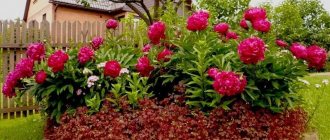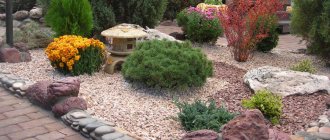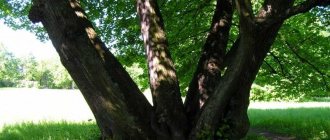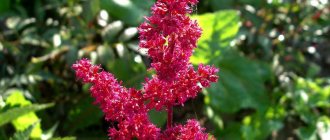The landscape design of a site depends on a large number of factors. When creating it, special attention must be paid to the selection of plants that can exist in a certain climate. One of the most popular plants for the site is heuchera. In this article we will talk about its types and options for use in landscape design of a site.
Plant characteristics
Heuchera is an ornamental plant, which is a composition of jagged leaves. It is popular for the different shades of these leaves and the ability to maintain a presentable appearance until late autumn. At the moment there are more than 70 varieties that can fit into any landscape. All of them are divided into forest and mountain.
Important! This plant is unpretentious, which will be a definite plus for those who do not have time to fully care for their flower beds.
Heuchera is appreciated by both beginners and professionals for the following qualities:
- The ability to create a bright accent on the site.
- Maintaining an attractive appearance throughout the season.
- Good survival rate in containers.
- Ability to adapt to any light intensity.
- Good tolerance to cold and temperature fluctuations.
- Simplicity and fast reproduction times.
- Resistance to the most common diseases.
- Low maintenance requirements.
- Get along with most other plants.
- Possibility of planting near ponds and on stone compositions.
Due to the variety of varieties that differ in appearance, heuchera can be used to decorate rockeries, rock gardens, multi-tiered flower beds and other plantings in the foreground.
Wintering perennial
The main thing that gardeners who have luxurious heuchera growing in their gardens should know is that it overwinters along with the leaves, and they cannot be cut off for the winter!
But because of this rule, after the bush comes out from under the snow into the first spring sun, there is a risk of getting burned, and gardeners sometimes believe that the plant simply did not survive the winter and remove it.
To prevent this situation, use non-fabric, which will help protect the crop from the scorching spring sun.
In October or March, a non-woven fabric is spread over the place where the heucheras overwinter, directly over the snow layer and securely fastened.
The material is removed in cloudy weather, somewhere in early May.
This saves the perennial leaves from burns and helps it quickly adapt to a new period of life.
Garden heuchera is impressive and delights even experienced gardening professionals.
With the help of this unique plant, you can create a magical picture in your garden plot, playing with the varied colors of leaves and flowers.
Be sure to decorate your garden and make it unforgettable with this magnificent shrub!
I suggest watching a few short videos about growing heuchera, which will help you learn even more about growing these wonderful plants.
See you soon, dear readers!
Popular varieties
Thanks to the ability of the plant to change the color of its leaves throughout the season, the garden always has an attractive atmosphere. Usually, at first the leaves are lighter in color and become darker towards the end of flowering. Often, gardeners at the end of the season collect the leaves of this plant and, combining with others, decorate their home with it, placing it in a vase. To better understand what this plant is, let’s consider its types.
Blood red
This plant belongs to the mountain type varieties and is characterized by high levels of endurance and unpretentiousness. The bush consists of dense round leaves with carved edges. Its appearance, which has light cream-colored spots on the surface of the foliage, is suitable for landscape design. This heuchera blooms with small bell-shaped flowers of red or pink color.
Important! The plant has medicinal properties.
Small-flowered
This type of plant is especially loved by landscape designers due to its chic appearance. The leaves are similar in design to maple leaves, their shades may be different. For example, bronze or purple, some have silver spots. The flowers stand out in large numbers and have a beige-pink hue.
Hairy heuchera
This variety is forest. The main feature of the plant is its large leaves with a velvety coating and elegant peduncles. The flowers are usually delicate shades of cream or light green.
Cylindrical Heuchera
This is a subspecies of a mountain type plant. It is distinguished by its larger size than all other mountain representatives. Heuchera received its name due to its inflorescence, which resembles the shape of a cylinder. Varieties of this type are distinguished by a wide range of flower colors.
Gooseberry-leaved heuchera
The plant is equipped with small three- or five-lobed leaves. But at the same time they are always collected in groups. Heuchera stems are long, reaching a height of 60 cm, with small white flowers at the ends.
Hybrid Heuchera
The name speaks for itself and means that this plant variety consists of several. In creating landscape design, all possible shapes and shades that are found in hybrid heuchera are used. The flowers of the plant also have different colors, which is an indicator of the popularity of the plant.
There are still many different varieties of this amazing plant, but we have presented only the most popular ones. Among the entire assortment, it is easy to choose exactly the plant that will ideally complement your garden plot.
Hello, dear readers!
The beauty of heuchera lies in its leaves, which are decorative in shape and very varied in color.
And if you add beautifully flowering varieties, then this plant can be called a universal perennial.
Heuchera is just a godsend for gardeners!
And I just can’t believe that this luxurious exotic plant grows quietly in our gardens.
But for many years now, magically beautiful crops have been inhabiting Russian areas, wintering well and delighting owners with the unique color of their foliage.
Heuchera leaves, planting which does not present any difficulties, have the ability to change their color, many times in one season.
This talent makes this species a favorite among decorative varieties and allows it to be used in the most extraordinary and daring design ideas when decorating garden areas.
Options for planting heuchera in the landscape
In the landscape, you can plant heuchera in almost any type of bed. It will look gorgeous in any flower garden. We will present interesting options for planting with heuchera in landscape design.
Solitaires
Heucheras will look elegant in single plantings, and you can combine several varieties with different leaf colors at once. But in design they need to be correctly combined.
You can use contrasting shades of heuchera flowers in the flowerbed, combining dark-leaved ones with light-leaved ones. Heuchera flower beds are also often created with flowers of the same color, but foliage of different textures. A flowerbed with a smooth color transition from light to dark looks great.
Advice! As tapeworms, heucheras will complement borders and ridges, and they are also often planted along garden stone paths.
But, since these plants do not really like direct sunlight and are small in height, it is better to plant coniferous, deciduous shrubs or ornamental grasses near them, which will provide partial shade.
In combination with shade-tolerant plants
Heuchera goes well with any shade-loving plants. Ferns and hostas can become optimal neighbors for it. If there are not enough colors in the flower garden, then you can plant dicentra. It is worth noting that its soft pink flowers go best with heucheras of purple, violet and burgundy shades. Blue forget-me-nots will add tenderness to a flower bed with salmon-colored heucheras.
If there must be large flowers on the site, then there is a solution for this in landscape design. Heucheras of different colors can frame a flower bed with daylilies or lilies. This flower bed configuration looks best along the wall of the house or near the fence.
Heucheras in an alpine hill
The rock garden is a good place to plant heuchera. They uniquely complement this solution if they are located in the foreground. In company with them may be daylilies and coniferous shrubs, which must be carefully trimmed.
Combination of hosta and heuchera
Flower growers especially liked the combination of hosta and heuchera due to the possibility of creating interesting landscape design projects. These plants have a large number of subspecies, so everyone can put together an individual flower garden.
Hostas in most cases are represented by green shades with the addition of white or blue, and heuchera has a red tone. These features allow you to show the contrast between types and emphasize each individually.
Varieties
Before planting and caring for perennial heuchera (photo), you need to choose the right variety that would fit into the flowerbed and become an important component in it. Of course, you need to consider how the leaves and peduncles are combined with other flowers.
Very beautiful deep dark burgundy leaf color. This heuchera will be the highlight of almost any composition.
Popular varieties:
- Alba. Flowers are 40-50 cm high, appear in mid-summer and remain on the stems until autumn. The foliage is bright green and the flowers are white.
- Robusta. The height of the flowers is 40-50 cm, they are dark red, quite large in comparison with other species. They will delight you at the beginning of summer. The leaves are green but change to red as the season progresses.
On the bush of this variety you can observe leaves of different colors and shades during the period of changing palette
- Snow storm. The flowers are not very high from the rosette, only 30 cm, they have a bright red color, which appears at the very end of autumn and beginning of summer. The leaves are variegated - white-green. Despite its appearance and name, it is not winter hardy.
- Splash. The flowers are located at a height of 30-40 cm, pink. They bloom in early summer. The leaves in this variety attract more attention than the flowers; they are very noticeable: the base is green, light green spots run along it, and the veins are crimson-red.
- Purple Castle. The flowers bloom at a height of 40-50 cm and delight with their white color from mid-spring until frost. The leaves are purple with a metallic tint.
The small flowers on the peduncles of Heuchera variety Purple Castle are white with a pinkish accent on the receptacle.
- Cappuccino. The height of the inflorescences is up to 50 cm, the color fully corresponds to the name of the variety, it pleases in the summer - for a couple of months. The leaves are mostly green, with veins interspersed with cream.
Heuchera cappuccino variety during flowering
- Rachel. Soft pink flowers bloom in summer, bronze-purple leaves.
Planting and caring for heuchera
Heuchera, as mentioned earlier, is a shade-loving plant, so it is better to plant it in a place where there is openwork shade from taller plants, shrubs or trees. It is best to place flower beds with heuchera away from buildings and tall trees in the west or east. The only exception to the rule is heuchera with red or pink foliage, which can be planted in a sunny meadow.
Advice! If the garden does not have a shaded area, then the heuchera can be planted in the sun, but it is important to water it regularly and abundantly.
Heucheras with purely green leaves are often planted in full shade, where they feel great. Those plant varieties where light shades predominate on the leaves should be placed in a flowerbed, which is dosed with sunlight so that the leaves do not darken.
For planting heucheras in open ground, choose April or early May, when the weather is not quite hot. This rule applies only to rooted cuttings. Regarding seedlings, we can say that they are planted only during a period when there is no threat of frost that will damage the leaves of the plant.
The main problem in caring for this plant is its capriciousness when wintering in central Russia. In order to grow a beautiful plant, you must first study its characteristics and care requirements.
Since the tops of the heuchera do not die off in the winter months, the main threat to it is the drying out of the leaves in the winter sun, since the roots cannot extract moisture from the frozen soil. Therefore, it is important to provide sufficient watering for the plant. This is done only at the root and with warm water. To protect the foliage, it is covered with coniferous spruce branches. You can also cover it with boxes, spunbond or lutrasil. Even fallen leaves will do in a pinch. The main thing is that the coating is loose enough to allow air to pass through. Protection from the plant is removed only in the spring, when the soil is sufficiently warmed up.
Heuchera does not accept excess moisture, which means it is afraid of snow melting in the spring. If the water stagnates for a long time, the leaf rosettes begin to rot. During this period, you need to be more careful about the condition of the plant. So, in the spring, when the days are warm and the nights are cold, the roots of the heuchera begin to protrude from the soil. If this is observed, then it is important to remove the plant from the soil in time, plant it at an acceptable depth and cover it with sawdust or humus.
If the ground is not yet soft enough, then you can not dig up the bush itself, but loosen the soil around it and mulch it. This will help the top layer of soil not to overheat during the day and not form an ice crust at night.
The roots of a young heuchera are much stronger than those of an old one, in which they have become lignified, so the former overwinter much easier than the latter. Adult plants need a constant flow of air, which is achieved by loosening the soil near planting. Mulching with organic matter will also help protect the roots.
Adult heuchera bushes often lose their central part after winter. This is the result of poor preservation of leaves and stems and their drying out. It is best to divide such a bush into several parts and plant each of them separately. Thus, the plant rejuvenates and its appearance improves.
Features of growing from seeds
Heuchera seeds are propagated relatively rarely, but this method is relevant for rare varieties for breeding purposes. Using it, you can get more plants in one season than by dividing the bush. It is important to take into account some features of seed propagation, namely:
- The seeds will sprout no later than 6 months after collection. If the package is sealed with foil, then 18 months.
Heuchera peduncle is cylindrical with pronounced green leaves with characteristic dark spots along the veins
- The soil should be loose, it is advisable to add fine-grained sand or perlite.
- Before sowing, the nutrient mixture must be heated in the oven, this will destroy all harmful organisms from the soil.
- You need to sow in well-moistened, loose soil.
- Before pecking the plants, the container should be covered with film.
- The first shoots appear after 2-3 weeks.
- As soon as the third leaf appears on the heuchera, each plant needs to be transplanted into an individual container.
- Before planting in a permanent place, young plants need to be hardened off for 7 days.
Young heuchera seedlings in a decorative corner in the courtyard of a private house
Botanical portrait and valuable qualities of the host
Hosta (funkia) is a herbaceous perennial with luxurious leaves, the variety of shapes, sizes, colors and textures of which is amazing. The plant has no stem, the bush is a basal rosette - the leaves rise above the ground on strong petioles, reminiscent of a magical fountain. In different varieties they can be green, bluish, silver, blue-green, light green, cream, golden yellow and variegated.
The sizes of the leaf plates vary: from 5 cm in miniature varieties to 25 cm in tall varieties. The shapes are also varied: elongated-pointed, almost round, heart-shaped, lanceolate, long and narrow, with a wavy edge. The leaves of different types of hosta also differ in texture: smooth and “crumpled”, matte and glossy, dense and thin, with almost imperceptible and clearly defined veins.
Tall peduncles of funcium, devoid of leaves, bear discreet but charming inflorescences consisting of mini-bells of white, lilac, pinkish or lavender. They do not attract much attention; the main decorative accent of these plants is their magnificent leaves.
In addition to their unique decorative qualities, hostas have a number of other advantages:
- unpretentiousness - do not require special care, do not impose significant requirements on soil quality;
- frost resistance - many varieties tolerate frosts of -30°C, some are not afraid of -40°C, and the most cold-resistant ones can withstand even -42°C;
- resistance to diseases - practically do not get sick;
- durability - they can grow in one place for up to a quarter of a century, becoming only more beautiful year after year;
- shade-tolerant and even shade-loving - they feel great in shade and partial shade, for which gardeners received the title “queens of shade.”
On a note! The host world is amazingly diverse. Some varieties of this crop show their best qualities when located not in the shade, but in well-lit areas. Of course, they also fit perfectly into various decorative compositions.











